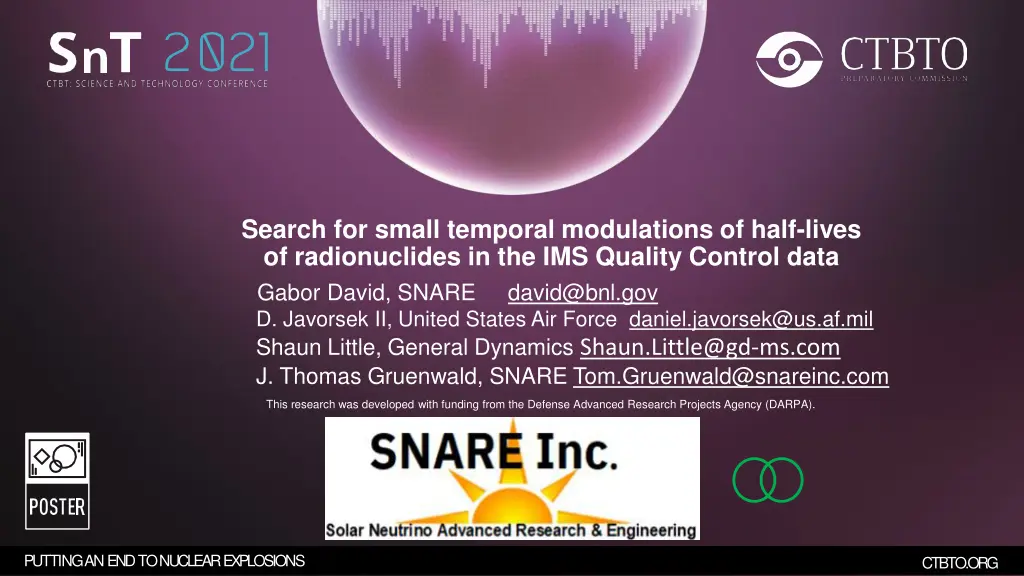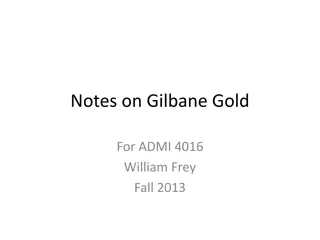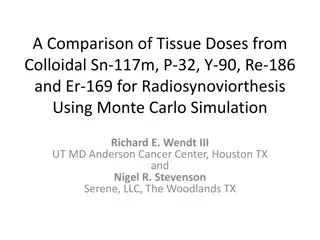
Investigating Temporal Modulations of Radionuclide Half-Lives in Quality Control Data
Explore the potential small temporal variations in radionuclide half-lives through in-depth analysis of IMS Quality Control data collected over 15 years. Could these fluctuations be linked to external influences like solar neutrinos? This research, supported by DARPA, aims to shed light on this intriguing phenomenon and its implications for nuclear physics.
Download Presentation

Please find below an Image/Link to download the presentation.
The content on the website is provided AS IS for your information and personal use only. It may not be sold, licensed, or shared on other websites without obtaining consent from the author. If you encounter any issues during the download, it is possible that the publisher has removed the file from their server.
You are allowed to download the files provided on this website for personal or commercial use, subject to the condition that they are used lawfully. All files are the property of their respective owners.
The content on the website is provided AS IS for your information and personal use only. It may not be sold, licensed, or shared on other websites without obtaining consent from the author.
E N D
Presentation Transcript
Search for small temporal modulations of half-lives of radionuclides in the IMS Quality Control data Gabor David, SNARE david@bnl.gov D. Javorsek II, United States Air Force daniel.javorsek@us.af.mil Shaun Little, General Dynamics Shaun.Little@gd-ms.com J. Thomas Gruenwald, SNARE Tom.Gruenwald@snareinc.com This research was developed with funding from the Defense Advanced Research Projects Agency (DARPA). PUTTINGANENDTONUCLEAREXPLOSIONS CTBTO.ORG
Search for small temporal modulations of half-lives of radionuclides in the IMS Quality Control data PosterNo.: T2.4-169 Gabor David, SNARE david@bnl.gov Abstract ABSTRACT Half-lives of radioisotopes have long been thought as absolute constants of Nature. However, since the 1980s several experiments indicated that small - percent or sub-percent level temporal modulations may exist, that can be correlated to variations of the solar neutrino flux. The issue has been hotly debated by the nuclear theory community, since it would imply some new mechanism influencing weak decays, and as such, of fundamental importance for nuclear physics. One problem is that high quality data collected over extensive period of time are scarce. As regular part of their operation, the IMS monitoring stations take so-called quality control data daily, measuring a source of known isotopes for 30 minutes. The stations are at diverse geographic locations and using standardized equipment and sources. Such data are in principle ideal to investigate long-term, small modulations of the half-lives due to a penetrating external influence, like solar neutrinos. We obtained and analyzed 15 years worth of quality control data from 11 IMS stations for annual and higher frequency modulations. We will present the results of this analysis, including an upper limit of the amplitude of the modulations and suggestions for the design of a future high-sensitivity experiment, dedicated to settle the issue of temporal modulations of half-lives due to solar influence. Disclaimer: The views, opinions and/or findings expressed are those of the author and should not be interpreted as representing the official views or policies of the Department of Defense or the U.S. Government. Disclaimer: Theviewsexpressed on thisposterarethose oftheauthoranddonotnecessarily reflecttheviewoftheCTBTO PUTTINGANENDTONUCLEAREXPLOSIONS CTBTO.ORG
Search for small temporal modulations of half-lives of radionuclides in the IMS Quality Control data PosterNo.: T2.4-169 Gabor David, SNARE david@bnl.gov The issue: are half-lives of radionuclides really constant, or do at least some of them exhibit small temporal variations due to external effects? Are half-lives really constant? INTRODUCTION Theoretically: several mechanisms suggested, like influence of solar neutrinos (flux changes with time!), but mostly they are phenomenological models, not ab initio calculations (yet). Experimentally: since the first observation of a very small annual modulation in 1986, a large number of measurements were made, some confirming, some rejecting the claim. Even where a signal is claimed, the modulation is in the 10-2 10-4range. For a review, see arXiv:2012.00153 The same BNL data plotted with absolute dates. The superimposed red curve is the variation of the inverse square distance from the Sun. The amplitude of the modulation is 10-3. Annual modulation from Alburger et al. Earth and Planetary Sci. Lett. 78 (1986) 168-176 Disclaimer: The views, opinions and/or findings expressed are those of the author and should not be interpreted as representing the official views or policies of the Department of Defense or the U.S. Government. Disclaimer: Theviewsexpressed on thisposterarethose oftheauthoranddonotnecessarily reflecttheviewoftheCTBTO PUTTINGANENDTONUCLEAREXPLOSIONS CTBTO.ORG
Search for small temporal modulations of half-lives of radionuclides in the IMS Quality Control data PosterNo.: T2.4-169 Gabor David, SNARE david@bnl.gov An opportunity: study IMS QC data! INTRODUCTION To study small, annual variations of half-lives long measurements are needed with very well-controlled equipment. For a search of effects from solar neutrinos multiple devices at various positions on Earth are optimal. The QC data from select IMS stations fulfill the above conditions, so they appeared to be a promising candidate for an opportunistic study. Typical daily 30 minutes spectrum taken with the Quality Control (QC) source, before backgroundsubtraction IMS mission: to identify airborne nuclides with intensity above normal background. Therefore,equipment at monitoring stations is optimized for stable gain, perfect energy measurement. Stable efficiency is less important, since spurious samples will then be analyzed in a dedicated lab, with different equipment. To control gain-variations, each day a reference source (60Co,137Cs, 152Eu) is moved in and measured for 30 minutes, providing very clean peaks at well-kown energies. However, the position of the reference source is not perfectly reproduced day-to-day. This is irrelevant for the IMS mission, but it is a serious problem for our purposes. Small variations of the source position do not affect measured line energies, but slightly change the measured daily rates (efficiency). Region around the 1333 keV line of60Co after backgroundsubtraction Disclaimer: The views, opinions and/or findings expressed are those of the author and should not be interpreted as representing the official views or policies of the Department of Defense or the U.S. Government. Disclaimer: Theviewsexpressed on thisposterarethose oftheauthoranddonotnecessarily reflecttheviewoftheCTBTO PUTTINGANENDTONUCLEAREXPLOSIONS CTBTO.ORG
Search for small temporal modulations of half-lives of radionuclides in the IMS Quality Control data PosterNo.: T2.4-169 Gabor David, SNARE david@bnl.gov Geographic locations and analyzable time intervals METHODS Daily decay rates for the 1333 keV 60Co line. Horizontal scale: elapsed years since Jan. 1, 2003. Even on this compressedscale one can see sudden shifts in the data, short-term variations exceeding statistical fluctuations, and downward skewed distributions (see later). Data passing our quality assurance criteria, mostly based on60Co lines. Alternating red and blue indicate periods where reasonable residuals can be obtained with one single exponential fit. Disclaimer: The views, opinions and/or findings expressed are those of the author and should not be interpreted as representing the official views or policies of the Department of Defense or the U.S. Government. Disclaimer: Theviewsexpressed on thisposterarethose oftheauthoranddonotnecessarily reflecttheviewoftheCTBTO PUTTINGANENDTONUCLEAREXPLOSIONS CTBTO.ORG
Search for small temporal modulations of half-lives of radionuclides in the IMS Quality Control data PosterNo.: T2.4-169 Gabor David, SNARE david@bnl.gov Decay rates, residuals, power spectra and the Fukushima event in the QC data METHODS One of the isotopes in the IMS QC source is137Cs. This plot shows the residuals for the 662 keV line for the days around March 11, 2011, when the Fukushima accident happened. Note the huge excess from contaminatedair (USP71 station). Power spectrum for the residuals of the 1173 keV line of60Co at USP70. Daily decay rates (top) and residuals from the 1173 keV line of 60Co at USP70. Note the sizeable downward fluctuations (residuals are a skewed, non-Gaussian distribution) Disclaimer: The views, opinions and/or findings expressed are those of the author and should not be interpreted as representing the official views or policies of the Department of Defense or the U.S. Government. Disclaimer: Theviewsexpressed on thisposterarethose oftheauthoranddonotnecessarily reflecttheviewoftheCTBTO PUTTINGANENDTONUCLEAREXPLOSIONS CTBTO.ORG
Search for small temporal modulations of half-lives of radionuclides in the IMS Quality Control data PosterNo.: T2.4-169 Gabor David, SNARE david@bnl.gov Spurious frequencies and powers (using real data) METHODS Power spectrum of an original time series of residuals (red graph) and with each residual randomized with its own statistical error, repeated 1,000 times. For a given time series, statistical fluctuations change the power, but do not introduce or make disappear spurious frequencies Power spectrum of an original time series (red graph) and from 10,000 shufflings (2D background, log z scale) For a given power, any frequency is produced with equal probability in shuffling (horizontal stripe structure) Disclaimer: The views, opinions and/or findings expressed are those of the author and should not be interpreted as representing the official views or policies of the Department of Defense or the U.S. Government. Disclaimer: Theviewsexpressed on thisposterarethose oftheauthoranddonotnecessarily reflecttheviewoftheCTBTO PUTTINGANENDTONUCLEAREXPLOSIONS CTBTO.ORG
Search for small temporal modulations of half-lives of radionuclides in the IMS Quality Control data PosterNo.: T2.4-169 Gabor David, SNARE david@bnl.gov Simulation of the effect of small variations in detector response METHODS Detector drift; same interval differentslopes introduce the same spurious frequencies with different power, inversely proportional to the slope Detector drift; same slope different time interval introducesspurious frequencies inversely proportional to the length of time Disclaimer: The views, opinions and/or findings expressed are those of the author and should not be interpreted as representing the official views or policies of the Department of Defense or the U.S. Government. Detector drift; different intervals and slopes: the effect of the two variables factorizes. Detector drift with a net offset (mean of residuals non-zero, which can happen for skewed distributions): a strong peak appears at zero frequency. Disclaimer: Theviewsexpressed on thisposterarethose oftheauthoranddonotnecessarily reflecttheviewoftheCTBTO PUTTINGANENDTONUCLEAREXPLOSIONS CTBTO.ORG
Search for small temporal modulations of half-lives of radionuclides in the IMS Quality Control data PosterNo.: T2.4-169 Gabor David, SNARE david@bnl.gov Detector study: a control experiment (TVD01) Control experiment: TVD01 (thanks to General Dynamics MS!) 4 months of data taking with IMS QC source First two weeks: the source is regularly moved in and out Rest of the time: the source is left in place METHODS QC source is behind the collimator, moved vertically in and out Residuals for the 1173 keV 60Co line at TVD01. In the first two weeks the source was moved in and out daily, then left in a stable position for the rest of the time the day-to-day fluctuations becomealmost purely statistical. HPGe detector assembly Cartoon: imperfect positioning changes the detector acceptance (measured rates!) Disclaimer: The views, opinions and/or findings expressed are those of the author and should not be interpreted as representing the official views or policies of the Department of Defense or the U.S. Government. Disclaimer: Theviewsexpressed on thisposterarethose oftheauthoranddonotnecessarily reflecttheviewoftheCTBTO PUTTINGANENDTONUCLEAREXPLOSIONS CTBTO.ORG
Search for small temporal modulations of half-lives of radionuclides in the IMS Quality Control data PosterNo.: T2.4-169 Gabor David, SNARE david@bnl.gov The most stable dataset: USP73 (Palmer Station,Antarctica) Sudden jumps in the data often come from changing the QC source, the detector or the high voltage, but not all changes could be explained. RESULTS The steep downward excursions in the 121, 244 and 344 keV152Eu lines are so far not understood. Composition of the IMS QC source Decay rates for all isotopes in the QC source (gamma lines). Horizontal scale: elapsed years since Jan. 1, 2003 Disclaimer: The views, opinions and/or findings expressed are those of the author and should not be interpreted as representing the official views or policies of the Department of Defense or the U.S. Government. Disclaimer: Theviewsexpressed on thisposterarethose oftheauthoranddonotnecessarily reflecttheviewoftheCTBTO PUTTINGANENDTONUCLEAREXPLOSIONS CTBTO.ORG
Search for small temporal modulations of half-lives of radionuclides in the IMS Quality Control data PosterNo.: T2.4-169 Gabor David, SNARE david@bnl.gov The most stable dataset: USP73 (Palmer Station,Antarctica) Power spectra for 60Co 1173 keV line (top) and 1333 keV line (bottom) with the powers from 1000 shufflings as background. Power spectra for152Eu 344 keV line (top) and 778 keV line (bottom) with the powers from 1000 shufflings as background. RESULTS Thesetwo lines come from the same decay chain, should be completely correlated and the respective power spectra should be nearly identical. Both lines come from b-decay, the respective power spectrashould be similar. Clearly they are not, indicating randomnessdue to detector effects. Clearly they are not, indicating randomnessdue to detector effects. Disclaimer: The views, opinions and/or findings expressed are those of the author and should not be interpreted as representing the official views or policies of the Department of Defense or the U.S. Government. Disclaimer: Theviewsexpressed on thisposterarethose oftheauthoranddonotnecessarily reflecttheviewoftheCTBTO PUTTINGANENDTONUCLEAREXPLOSIONS CTBTO.ORG
Search for small temporal modulations of half-lives of radionuclides in the IMS Quality Control data PosterNo.: T2.4-169 Gabor David, SNARE david@bnl.gov Some results from TVD01 --152Eu, b-decay and EC (electron capture) Power spectra, EC lines: 121 keV (left), 964 keV (right) Different pattern, and all powers buried deep in the random shuffled background RESULTS Power spectra, b-lines: 344 keV (left), 778 keV (right) Different pattern, and all powers buried deep in the random shuffled background Note that this is a very short measurement, only 3.5 months with stable source! Disclaimer: The views, opinions and/or findings expressed are those of the author and should not be interpreted as representing the official views or policies of the Department of Defense or the U.S. Government. Disclaimer: Theviewsexpressed on thisposterarethose oftheauthoranddonotnecessarily reflecttheviewoftheCTBTO PUTTINGANENDTONUCLEAREXPLOSIONS CTBTO.ORG
Search for small temporal modulations of half-lives of radionuclides in the IMS Quality Control data PosterNo.: T2.4-169 Gabor David, SNARE david@bnl.gov Summary and outlook CONCLUSIONS The IMS QC data are perfect for the IMS mission, but inadequate for the study of temporal modulation of the decay rates at the percent level or below (where some experiments claim to have found it). The principal reason is low statistics and day-to-day variations in the positioning of the QC source. In certain short (1-3 years) intervals and certain stations we found hints of an 0.01 amplitude annual modulations, but no convincing evidence. Detailed results of these studies will be published soon. Simulations have shown that the signal/noise ratio (from statistical error and any detector instabilities) should be at least S/N>1/3, preferably even higher. This puts a lower limit on count-rates in a future precision experiment. Based on our studies and the lessons learned from the TVD01 control experiment, we are working on a proposal for a new precision experiment, largely based on existing IMS (GDMS) hardware. Disclaimer: The views, opinions and/or findings expressed are those of the author and should not be interpreted as representing the official views or policies of the Department of Defense or the U.S. Government. Disclaimer: Theviewsexpressed on thisposterarethose oftheauthoranddonotnecessarily reflecttheviewoftheCTBTO PUTTINGANENDTONUCLEAREXPLOSIONS CTBTO.ORG






















